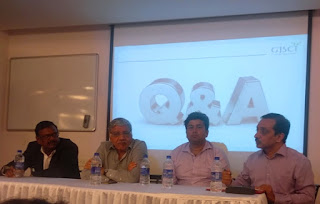GJSCI gears up for Artisans at Zaveri Bazar!
There
are about 70,000
artisans
& craftsmen in Zaveri Bazar!
Recently
Gem and Jewellery Skill council of India (GJSCI) hosted its first Press Meet
after Mr Sanjay Kothari taken over the charge as the new Chairman of GJSCI. GJSC
looks forward to gain larger participation from the industry and attract fresh
focus on its various skilling activities and initiatives.
Being a Chairman, Sanjay Kothari shared his
vision for GJSCI:
1: to ensure that all the current
workforce is certified based on NSQF aligned QP/NOS;
-at least one train the trainer
institution per cluster;
2: improving the skills of workforce to
make them ready for modern factories;
3: improving the company management
skill so that they can be ideal entrepreneurs on their own;
4: ensure that the next generation of
workforce comes into the business;
5: make India a world leader in
jewellery manufacturing after attaining leadership position in diamonds and some varieties of coloured
stones.
So
far GJSCI has successfully imparted training to candidates in various fields of
the gem and jewellery industry through different schemes. Since inception GJSCI has trained and
certified 133230 candidates under Short Term Training (STT) and 24141 artisans
under Recognition of Prior Learning (RPL). GJSCI is also affiliated with 150+
Training Partners and 35+ Assessment Agencies across the country.
 Apprenticeship
Training is a course that comprises basic and practical training at the
workplace, in an industry or establishment.
An apprentice is a person who has signed a contract of apprenticeship
with an establishment to undergo apprenticeship training.
Apprenticeship
Training is a course that comprises basic and practical training at the
workplace, in an industry or establishment.
An apprentice is a person who has signed a contract of apprenticeship
with an establishment to undergo apprenticeship training.
In
a direct question about all those artisans & craftsmen at Zaveri Bazar,
Sanjay Kothari said definitely they are looking at the segment to accommodate
all those Babus in to RPL programme of GJSCI. Sooner he would initiate and
visit Zaveri Bazar!
Question was asked by Nayan Jani that there are about 70K
artisans & craftsmen in Zaveri Bazar, why they are not accommodated under
the RPL programme so far?
It
was announced in the meet that, GJSCI along with NSDC is going to conduct a
Road show in SEEPZ where in the Joint Secretary from the Ministry of Skill
Development and Entrepreneurship, GoI would be present to highlight the new
features of revamped Apprenticeship Act 1961 and National Apprenticeship
Promotion Scheme (NAPS).Chairman GJSCI urges all the industry HR Heads and
promoters to attend this important event and take advantage of this opportunity.
There
are various other initiatives being undertaken by GJSCI. Some of these are,
Project Vanika:
This
is an initiative to train tribal women in the art of jewellery making to secure
a source of income and livelihood and self-sustainability. This would greatly reduce the rate of
migration of tribal’s.
Project Rupaantar:
A
project dedicated for the transformation of the lives of prisoners by imparting
skills and securing a source of income on release and respect in society. This would eventually bring about a change in
mind-set of inmates and ensure a better future.
Project Hupari:
An
endeavour to transform Hupari, the silver town, into a skill hub is Project Hupari. GJSCI
looks forward to enhance the ancient methods of silver manufacturing to
advanced use of technology by securing health and hygiene as compared to the methods
being presently followed. This would be
a great impact on qualitative and quantitative production of silver ornaments.
The
Chairman also called upon Training Institutes to join hands with GJSCI towards
imparting skilling as an Assessment Agency or Training Partner as all the
curriculum and qualification packs are aligned to NSQF levels based on
international standards. This Press Meet
also focused on the roles of the Training Partners and the Assessment Agencies.
GJSCI
has a mandate of: 1: Identification of skill development needs including
preparing a catalogue of types of skills, range and depth of skills to
facilitate individuals to choose from them. 2: Development of a sector skill
development plan and maintain skill inventory. 3: Determining skills /
competency standards and qualifications.
4: Standardization of
affiliation and accreditation process. 5: Participation in Affiliation,
accreditation, examination and certification. 6: Plan and execute Training of
Trainers. 7: Promotion of academies of excellence. 8: Establishment of a
well-structured sector specific Labour Market Information System (LMIS) to
assist planning and delivery of training.





Comments
Post a Comment